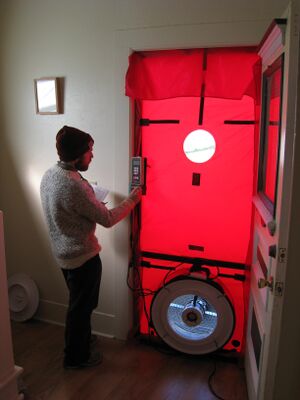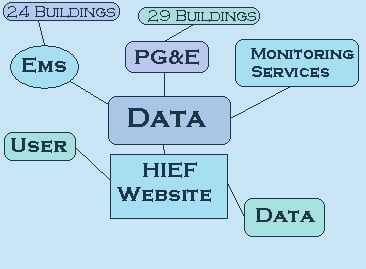Nate gates (talk | contribs) No edit summary |
Sophivorus (talk | contribs) m (Rename "affiliations" parameter to "organizations", to unify terminology throughout Appropedia) |
||
| (158 intermediate revisions by 12 users not shown) | |||
| Line 1: | Line 1: | ||
[[File:Air Blower Test.JPG|thumb|3)Nathan Chase checks the output of a blower door test in ENGR 473 Building Energy Analysis (spring 2009)]] | |||
HEIF <ref>http://www.humboldt.edu/ | {{Project data | ||
</ref> | | authors = User:Joshua Rodriguez, User:Nate gates | ||
</ref> where | | location = Arcata, California | ||
}} | |||
{{HEIF menu}} | |||
The Energy Monitoring station at Cal Poly Humboldt (HSU)<ref>http://www.humboldt.edu/</ref> in California | |||
, started in December 2008 where one of the many projects under the Humboldt Energy Independence Fund (HEIF).<ref>http://web.archive.org/web/20100605013159/http://www.humboldt.edu/%7Eheif/</ref> This on-going project is responsible for collecting, analyzing and publishing specific energy usage for campus and community use. The idea was created after a program that was similar to UC Davis'<ref>http://web.archive.org/web/20171221233432/http://facilities.ucdavis.edu/Dashboard/</ref> energy monitoring system, where their information is about specific building energy usage. This information has a variety of uses which may result in less electricity use by Cal Poly Humboldt. Previously the information was thought that the electric and gas meters installed throughout the campus were not monitored by any outside sources. With the proposal of this project, it turns out that the information was collectively stored within the meters without anyone knowing this fact. However the information was kept in a log book in HSU's Plant Operations, so that data was not available for student use. | |||
=== Possible Benefits of Accessible Data === | |||
[[File:Campus Energy Monitoring Color.jpg|2)Here is a flow chart of what the data is going to go through|thumb|400px]] | |||
Here are some proposed uses for the complied and analyzed energy data:<ref>http://web.archive.org/web/20100605013159/http://www.humboldt.edu/%7Eheif//proposals/RESU_building_intern_fall_08.pdf</ref> | |||
* developing baseline energy consumption estimates across campus<br> | |||
* identifying candidate buildings in need of more detailed evaluation<br> | |||
* prioritizing energy efficiency projects by their relative impact on energy use<br> | |||
* providing critical quantitative inputs for future HEIF proposals<br> | |||
* monitoring and quantitatively assessing the impact of energy efficiency retrofits and<br> | |||
* outreach programs funded by HEIF<br> | |||
* educating the HSU community about building energy efficiency and conservation<br> | |||
* planning, maintenance, and operational decision-making by Plant Operations<br> | |||
The flowchart on the right shows where the information goes before it gets compiled. | |||
== The Internship == | == The Internship == | ||
The | |||
The primary goal of the intern is to collect and compile gas and electric data form various buildings on campus. Energy data is critical for [[HSU]] staff, faculty and students, however it is currently collected in an ad hoc fashion. This type of accumulation happens due to the fact that there is no set time in which it's collected, only when ever someone accesses the Energy Monitoring System(EMS). Students interested in the energy monitoring internship may be eligible for the hiring process and is not required to have set work hours. The student may complete their submission whenever the student has availability within their school schedule or other previous engagements. | |||
=== Duties === | === Duties === | ||
The intern is responsible for collecting the data that the EMS collects and putting | |||
* | The intern is responsible for collecting the data that the EMS collects and putting this data in an understandable form. The current intern, Nathan Chase, is not responsible for community outreach because the program, Green Campus, has more experience communicating to the community and educating students here on campus about energy efficiency. Green Campus<ref>http://web.archive.org/web/20100325220919/http://www.humboldt.edu:80/~greenhsu/cms/</ref> is a grass roots program that works to develop energy awareness amongst the community. One of the projects that HEIF is currently doing, is to raise energy awareness by having a building energy competition, to see which building is using the least amount of energy across campus. Some of the goals to which Nathan hopes to accomplish are; | ||
*Code a program to disseminate the raw energy data. | |||
* Creating a new website for HEIF with a better design and layout. | |||
* Code a program to disseminate the raw energy data. | |||
=== Requirements === | === Requirements === | ||
To be eligible for the Campus Energy Monitoring internship, the requirements are to attend Cal Poly Humboldt and have the technical qualifications by completing the ENGR. 473 course here at Humboldt State. Then the hiring process into becoming the intern, is to have a creative job description about what the intern plans to do with the job and then submit their resume to Plant Ops. Nathan Chase says, on a day to day basis, he had to sort out raw data and understand how to navigate a computer. To qualify for the internship position, Nathan must have these skills prior to the position such as | |||
* | * Building retrofits | ||
* | * Programing background | ||
* | * Energy Retrofits | ||
=== Current Intern === | |||
The internship position is currently filled by Nathan Chase, an HSU student here on campus. Right now, Nathan is in the progress of developing a program that uses the data presented by the EMS, and transferring the data into a readable excel spreadsheet. During this progress, Nathan encountered a problem with accessing files held by the HSU Plant Operations<ref>http://web.archive.org/web/20100530100423/http://www.humboldt.edu/%7Eplantops/</ref> in which all the information was kept locked under the main server. Once completed with the program, the data will be more accessible to viewers in need of this information. | |||
With Nathan's continued effort to sort out the raw data, there is no tangible data available to the public to view. As of yet, there has been no reduction in energy usage or comparisons, due to the fact that the data has yet to be compiled and analyzed. | |||
[[File:NRRoof Pnrma.jpg|thumb|center|900px|1)ENGR 473 students investigate the air handling units for the Natural Resources Building in preparation for a full scale energy audit and energy retrofit modeling project. (spring 2009)]] | |||
== References == | == References == | ||
<references/> | |||
<references /> | |||
[[Category: | |||
Image Sources:<br> | |||
1)Peter Johnstone<br> | |||
2)Nathan Gates<br> | |||
3)Peter Johnstone<br> | |||
{{Page data | |||
| part-of = Engr115 Intro to Engineering, Humboldt Energy Independence Fund (HEIF) | |||
| keywords = energy, energy monitoring | |||
| organizations = Cal Poly Humboldt | |||
| sdg = SDG07 Affordable and clean energy | |||
}} | |||
[[Category:Energy]] | |||
Latest revision as of 16:01, 29 January 2024

The Energy Monitoring station at Cal Poly Humboldt (HSU)[1] in California , started in December 2008 where one of the many projects under the Humboldt Energy Independence Fund (HEIF).[2] This on-going project is responsible for collecting, analyzing and publishing specific energy usage for campus and community use. The idea was created after a program that was similar to UC Davis'[3] energy monitoring system, where their information is about specific building energy usage. This information has a variety of uses which may result in less electricity use by Cal Poly Humboldt. Previously the information was thought that the electric and gas meters installed throughout the campus were not monitored by any outside sources. With the proposal of this project, it turns out that the information was collectively stored within the meters without anyone knowing this fact. However the information was kept in a log book in HSU's Plant Operations, so that data was not available for student use.
Possible Benefits of Accessible Data[edit | edit source]

Here are some proposed uses for the complied and analyzed energy data:[4]
- developing baseline energy consumption estimates across campus
- identifying candidate buildings in need of more detailed evaluation
- prioritizing energy efficiency projects by their relative impact on energy use
- providing critical quantitative inputs for future HEIF proposals
- monitoring and quantitatively assessing the impact of energy efficiency retrofits and
- outreach programs funded by HEIF
- educating the HSU community about building energy efficiency and conservation
- planning, maintenance, and operational decision-making by Plant Operations
The flowchart on the right shows where the information goes before it gets compiled.
The Internship[edit | edit source]
The primary goal of the intern is to collect and compile gas and electric data form various buildings on campus. Energy data is critical for HSU staff, faculty and students, however it is currently collected in an ad hoc fashion. This type of accumulation happens due to the fact that there is no set time in which it's collected, only when ever someone accesses the Energy Monitoring System(EMS). Students interested in the energy monitoring internship may be eligible for the hiring process and is not required to have set work hours. The student may complete their submission whenever the student has availability within their school schedule or other previous engagements.
Duties[edit | edit source]
The intern is responsible for collecting the data that the EMS collects and putting this data in an understandable form. The current intern, Nathan Chase, is not responsible for community outreach because the program, Green Campus, has more experience communicating to the community and educating students here on campus about energy efficiency. Green Campus[5] is a grass roots program that works to develop energy awareness amongst the community. One of the projects that HEIF is currently doing, is to raise energy awareness by having a building energy competition, to see which building is using the least amount of energy across campus. Some of the goals to which Nathan hopes to accomplish are;
- Creating a new website for HEIF with a better design and layout.
- Code a program to disseminate the raw energy data.
Requirements[edit | edit source]
To be eligible for the Campus Energy Monitoring internship, the requirements are to attend Cal Poly Humboldt and have the technical qualifications by completing the ENGR. 473 course here at Humboldt State. Then the hiring process into becoming the intern, is to have a creative job description about what the intern plans to do with the job and then submit their resume to Plant Ops. Nathan Chase says, on a day to day basis, he had to sort out raw data and understand how to navigate a computer. To qualify for the internship position, Nathan must have these skills prior to the position such as
- Building retrofits
- Programing background
- Energy Retrofits
Current Intern[edit | edit source]
The internship position is currently filled by Nathan Chase, an HSU student here on campus. Right now, Nathan is in the progress of developing a program that uses the data presented by the EMS, and transferring the data into a readable excel spreadsheet. During this progress, Nathan encountered a problem with accessing files held by the HSU Plant Operations[6] in which all the information was kept locked under the main server. Once completed with the program, the data will be more accessible to viewers in need of this information.
With Nathan's continued effort to sort out the raw data, there is no tangible data available to the public to view. As of yet, there has been no reduction in energy usage or comparisons, due to the fact that the data has yet to be compiled and analyzed.

References[edit | edit source]
- ↑ http://www.humboldt.edu/
- ↑ http://web.archive.org/web/20100605013159/http://www.humboldt.edu/%7Eheif/
- ↑ http://web.archive.org/web/20171221233432/http://facilities.ucdavis.edu/Dashboard/
- ↑ http://web.archive.org/web/20100605013159/http://www.humboldt.edu/%7Eheif//proposals/RESU_building_intern_fall_08.pdf
- ↑ http://web.archive.org/web/20100325220919/http://www.humboldt.edu:80/~greenhsu/cms/
- ↑ http://web.archive.org/web/20100530100423/http://www.humboldt.edu/%7Eplantops/
Image Sources:
1)Peter Johnstone
2)Nathan Gates
3)Peter Johnstone